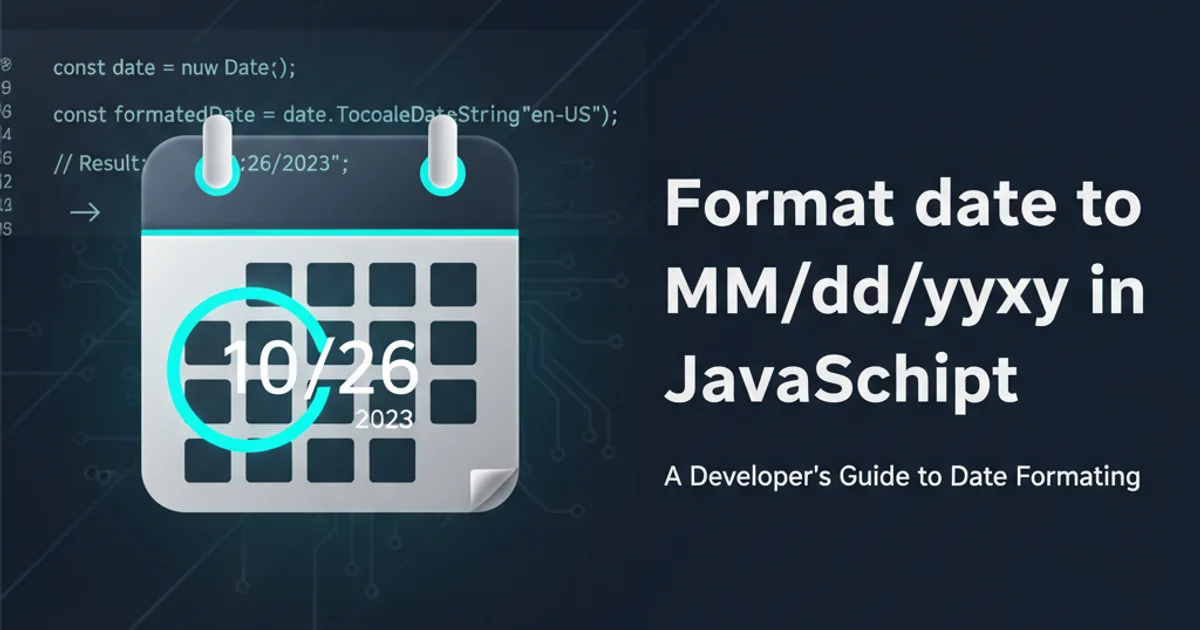Format date to MM/dd/yyyy in JavaScript
Categories:
Mastering Date Formatting to MM/dd/yyyy in JavaScript

Learn various techniques to format JavaScript Date objects into the common MM/dd/yyyy string format, covering native methods, custom functions, and popular libraries.
Formatting dates is a common task in web development, especially when displaying information to users or interacting with APIs. JavaScript's native Date object provides a robust way to handle dates and times, but its default string representations often don't match the MM/dd/yyyy format commonly used in the United States and other regions. This article will guide you through different approaches to achieve this specific format, from simple native methods to more advanced custom functions and external libraries.
Understanding the MM/dd/yyyy Format
The MM/dd/yyyy format specifies the month (two digits), day (two digits), and year (four digits), separated by forward slashes. It's crucial to ensure that single-digit months and days are padded with a leading zero (e.g., January becomes 01, and the 5th day becomes 05). The year should always be represented with four digits.
flowchart TD
A[Start with Date Object] --> B{Extract Month, Day, Year}
B --> C{Pad Month with leading zero if < 10}
C --> D{Pad Day with leading zero if < 10}
D --> E{Combine as 'MM/dd/yyyy'}
E --> F[Formatted String]Conceptual flow for formatting a date to MM/dd/yyyy
Native JavaScript Methods
While JavaScript doesn't have a direct format() method for dates like some other languages, you can construct the desired format using the Date object's getter methods. This approach gives you full control and doesn't require any external dependencies.
function formatDateNative(date) {
const year = date.getFullYear();
const month = String(date.getMonth() + 1).padStart(2, '0'); // Months are 0-indexed
const day = String(date.getDate()).padStart(2, '0');
return `${month}/${day}/${year}`;
}
const today = new Date();
console.log(formatDateNative(today)); // Example: 01/23/2024
const specificDate = new Date('2023-07-05T10:00:00');
console.log(formatDateNative(specificDate)); // Example: 07/05/2023
Formatting a date using native JavaScript Date methods and padStart().
getMonth() returns a zero-based index (0 for January, 11 for December), so you always need to add 1 to get the correct month number. The padStart(2, '0') method is excellent for ensuring two-digit output for months and days.Using the Intl.DateTimeFormat API
The Intl.DateTimeFormat object is part of the ECMAScript Internationalization API and provides language-sensitive date and time formatting. It's a powerful tool for handling various locales and formats, including MM/dd/yyyy.
function formatDateIntl(date) {
const options = {
year: 'numeric',
month: '2-digit',
day: '2-digit'
};
// 'en-US' locale typically uses MM/dd/yyyy or similar
return new Intl.DateTimeFormat('en-US', options).format(date);
}
const today = new Date();
console.log(formatDateIntl(today)); // Example: 01/23/2024
const specificDate = new Date('2023-07-05T10:00:00');
console.log(formatDateIntl(specificDate)); // Example: 07/05/2023
Formatting a date using Intl.DateTimeFormat for locale-sensitive output.
Intl.DateTimeFormat API is generally well-supported across modern browsers and Node.js environments. It's the recommended native approach for internationalization, as it handles locale-specific nuances automatically.Leveraging Libraries: Moment.js (Legacy) and date-fns
For more complex date manipulations, parsing, and formatting, libraries can significantly simplify your code. While Moment.js was a long-standing favorite, date-fns is a modern, modular, and immutable alternative that is often preferred in new projects.
Moment.js (Legacy)
// First, install Moment.js: npm install moment import moment from 'moment';
function formatDateMoment(date) { return moment(date).format('MM/DD/YYYY'); }
const today = new Date(); console.log(formatDateMoment(today)); // Example: 01/23/2024
const specificDate = new Date('2023-07-05T10:00:00'); console.log(formatDateMoment(specificDate)); // Example: 07/05/2023
date-fns
// First, install date-fns: npm install date-fns import { format } from 'date-fns';
function formatDateFns(date) { return format(date, 'MM/dd/yyyy'); }
const today = new Date(); console.log(formatDateFns(today)); // Example: 01/23/2024
const specificDate = new Date('2023-07-05T10:00:00'); console.log(formatDateFns(specificDate)); // Example: 07/05/2023
date-fns offers a more modern, tree-shakable, and immutable approach to date manipulation.